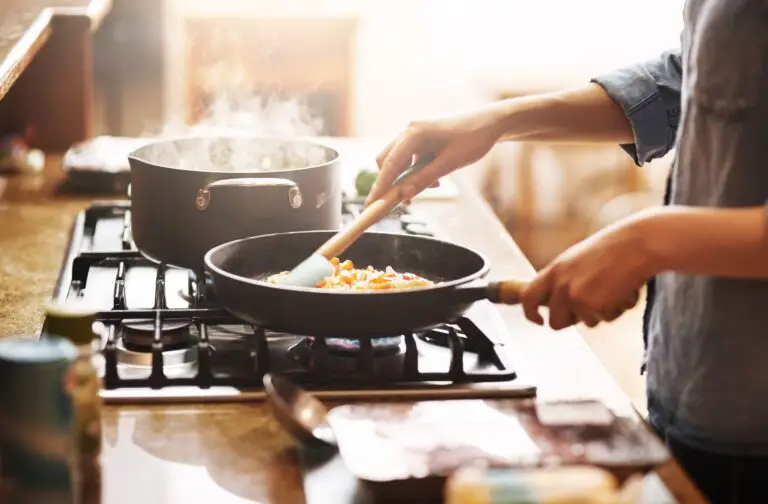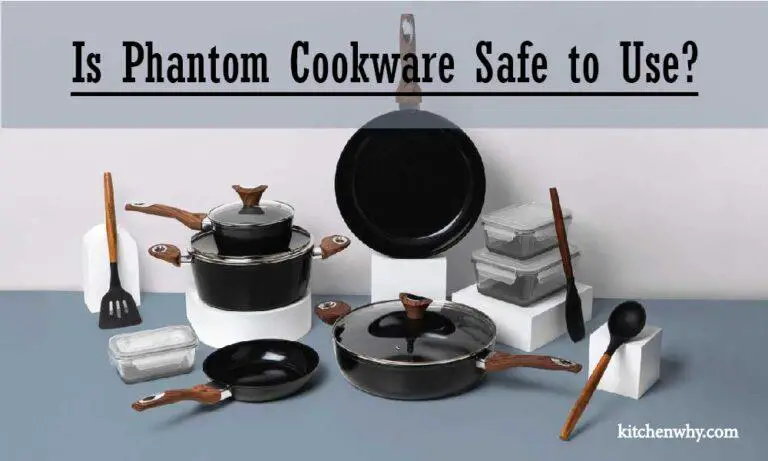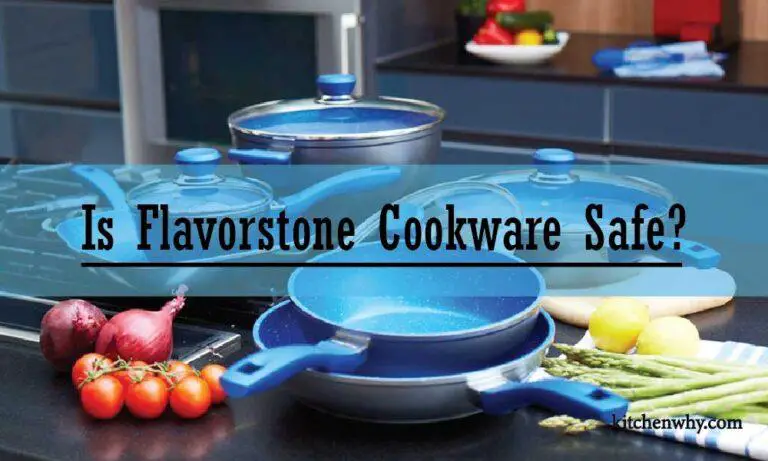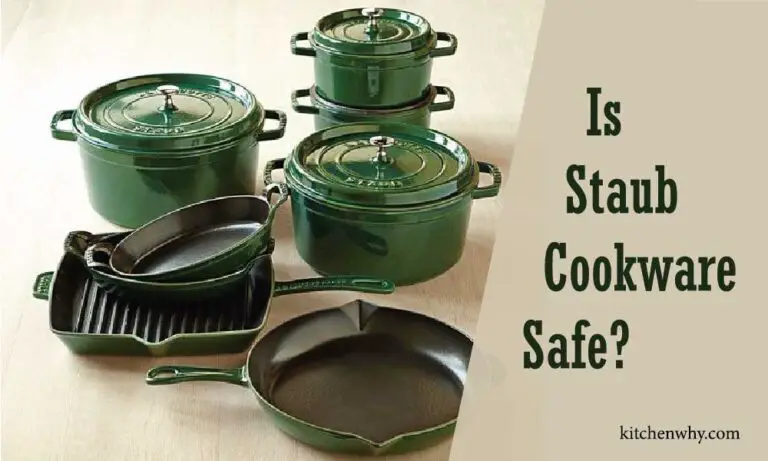Why Do Frying Pans Bow in the Middle: Unveiling the Culprit

Frying pans bow in the middle due to uneven heating and thermal expansion. This causes the metal to warp and lose its flat shape.
Frying pans are a kitchen essential for cooking delicious meals, but have you ever wondered why they sometimes bow in the middle? Well, the answer lies in the way heat is distributed and how metals react to temperature changes. When you heat up a frying pan, the metal expands as it gets hotter.
However, this expansion is not always uniform throughout the pan. The center of the pan tends to heat up faster than the edges because it is directly in contact with the heat source. This uneven heating causes the metal to warp and lose its flat shape, resulting in a noticeable bow in the middle of the pan. In this article, we will explore the reasons behind this phenomenon and discuss how to prevent it from happening.
why do frying pans bow in the middle?
Frying pans can bow or warp in the middle due to several reasons, mainly related to temperature changes and cooking practices. Here are some of the common reasons why this can happen:
- Thermal Expansion and Contraction: Frying pans are usually made of metal, and when they are heated, they expand due to thermal expansion. As the pan heats up, the metal expands unevenly, and this can cause the center of the pan to bow or rise slightly. When the pan cools down after cooking, it contracts, and this repeated expansion and contraction over time can lead to permanent warping.
- High Heat: Cooking with excessively high heat can contribute to warping. If a frying pan is subjected to high temperatures, it can cause the metal to distort and bend, especially in the center where the heat is concentrated.
- Uneven Heating: Uneven distribution of heat on the cooking surface can also be a factor. If the pan doesn’t have even heat distribution, it can lead to localized hotspots, causing the metal to warp more in those areas.
- Thermal Shock: Subjecting a hot pan to rapid temperature changes, such as placing it under cold water immediately after cooking, can cause stress on the metal, leading to warping.
- Storage and Handling: How a frying pan is stored and handled can also impact its shape. Stacking heavy objects on top of the pan or dropping it can contribute to bending and warping over time.
- Quality of the Pan: The quality and thickness of the metal used in the frying pan can affect its resistance to warping. High-quality, thicker pans are generally more resistant to warping than thinner, lower-quality ones.
To minimize the risk of warping, it’s essential to use the frying pan within its recommended temperature range, avoid extreme heat, and allow it to cool naturally after cooking. Additionally, using the appropriate heat settings and avoiding thermal shock can help prolong the lifespan of your frying pan. Finally, storing the pan properly, such as hanging it or placing it flat in a kitchen cabinet, can also help maintain its shape and prevent warping.
Credit: issuu.com
The Role Of Heat Distribution In Frying Pan Bowing
Frying pans are essential tools in the kitchen, but have you ever noticed that some frying pans develop a noticeable bow in the middle over time? This phenomenon can be frustrating, affecting cooking efficiency and even posing the risk of spillage.
So, why do frying pans bow in the middle? One significant factor that contributes to this issue is the distribution of heat across the pan’s surface. Understanding the role of heat distribution in frying pan bowing can help us grasp the underlying causes and seek solutions to prevent it.
Let’s delve into the various factors affecting heat distribution in frying pans.
Factors Affecting Heat Distribution In Frying Pans
The material composition of the frying pan:
- The type of material used in the frying pan greatly influences its heat conductance and distribution.
- Materials such as copper and aluminum offer excellent heat conductivity, ensuring more uniform heat distribution throughout the pan.
- Stainless steel pans, on the other hand, may have lower heat conductivity, resulting in uneven heating patterns and potential bowing in the middle.
The thickness of the frying pan:
- The thickness of a frying pan plays an important role in heat distribution.
- Thicker pans tend to distribute heat more evenly, reducing the chances of bowing in the middle.
- Thinner pans, on the contrary, may heat up more quickly in certain areas, creating a hotspot that causes the pan to warp.
Quality of the frying pan coating:
- The coating or finish applied to the frying pan’s surface can impact heat distribution.
- Non-stick coatings are designed to enhance heat conduction and reduce hotspots, ensuring more even cooking.
- However, poor-quality coatings or wear and tear over time can compromise their effectiveness, leading to uneven heating and potential bowing.
Heat source efficiency:
- The efficiency of the heat source you use for cooking can affect heat distribution in the frying pan.
- Gas stoves generally provide more precise temperature control and even heat distribution compared to electric cooktops.
- Uneven heat from an inefficient heat source can cause localized heat concentration and contribute to bowing in the middle.
By considering these factors affecting heat distribution in frying pans, we can make more informed choices when selecting the right cookware for our needs. Additionally, understanding these factors allows us to take precautionary measures to prevent or minimize the bowing of frying pans, ensuring a more enjoyable and efficient cooking experience.
So, let’s dive deeper into each of these factors to gain a better understanding and maintain the longevity of our frying pans.
The Impact Of High Heat On Frying Pans
Frying pans are an essential tool in every kitchen, allowing us to cook a wide variety of dishes with ease. However, have you ever wondered why some frying pans start to bow in the middle after repeated use? Well, the answer lies in the impact of high heat on these cooking utensils.
Let’s explore the reasons behind this phenomenon and understand the science behind frying pan bowing.
Thermal Expansion Of The Frying Pan
- When a frying pan is subjected to high heat, it undergoes a process called thermal expansion.
- Thermal expansion refers to the expansion of an object when it is heated, causing it to increase in size.
- This expansion is a result of the particles within the frying pan gaining kinetic energy and moving more vigorously.
Difference In Expansion Rates Of Different Materials
- Frying pans are made from various materials, such as stainless steel, cast iron, aluminum, or copper, each with different expansion rates.
- These different expansion rates can contribute to the phenomenon of bowing in the middle.
- For example, if the center of the frying pan expands more than the outer edges, it can cause the pan to bow upwards.
Effects Of Uneven Heat Distribution
- Uneven heat distribution is another factor that can lead to bowing in frying pans.
- This can occur when the heat is concentrated more in the center of the pan, causing the center to expand more rapidly than the rest of the pan.
- The uneven expansion then leads to the pan bowing in the middle.
The Bowing Process Explained
- As the frying pan is heated, the metal expands, including the bottom and sides of the pan.
- However, due to the uneven expansion rates or uneven heat distribution, the middle section of the pan expands more than the outer edges.
- This causes the pan to deform and bow upwards, resulting in a concave surface in the middle.
- Over time, repeated heating and cooling cycles can further worsen the bowing, making the pan less effective for cooking.
The impact of high heat on frying pans goes beyond cooking your favorite dishes. Understanding the thermal expansion of frying pans, the difference in expansion rates of different materials, the effects of uneven heat distribution, and the bowing process can help you choose the right frying pan for your cooking needs.
So next time you’re frying up some bacon or flipping pancakes, take note of the changes happening to your trusty frying pan and appreciate the science behind its bowing.
The Culprit Behind Bowing Frying Pans: Warping
Have you ever noticed your frying pan start to bow in the middle over time? This common occurrence can be frustrating, especially when it affects the cooking performance of your pan. But what actually causes frying pans to bow in the middle?
The answer lies in a phenomenon called warping, which can occur due to uneven heat distribution and affect both the bottom surface and the sides of the pan. Let’s explore how warping leads to the bowing effect and what you can do to prevent it.
Warping Due To Uneven Heat Distribution
- The primary reason frying pans warp is the uneven distribution of heat during the cooking process.
- When subjected to high heat, the pan expands, and if the heat is not evenly distributed, certain areas of the pan will expand more than others.
- This uneven expansion causes stress on the metal, eventually leading to warping.
Warping Of The Bottom Surface
- Warping of the bottom surface is a common issue with frying pans. It usually occurs when the heat source is not properly centered on the pan’s bottom.
- As the pan heats up, the area closer to the heat source expands more rapidly, causing the center of the bottom surface to bow outwards.
- This not only affects the cooking performance but also can lead to unstable contact between the pan and the heat source.
Warping Of The Sides
- Bowing of the sides of a frying pan is another form of warping that can occur, although less frequently than the bottom surface warping.
- The sides of the pan may bow outwards due to the uneven heat distribution, particularly if the heat source is not centered or if one side of the pan is receiving more heat than the other.
- Warping of the sides can result in uneven cooking and make flipping or stirring food more challenging.
How Warping Leads To The Bowing Effect
- The uneven expansion and warping of the frying pan lead to the bowing effect, where the middle of the pan lifts upwards, creating an uneven surface.
- A bowing frying pan can cause oil and food to collect in the middle, making it difficult to cook evenly.
- It can also affect heat distribution, leading to hot spots and inconsistent cooking results.
Understanding the causes of warping and its impact on frying pans can help you take preventive measures to maintain the performance and lifespan of your cookware. Regularly check the heat distribution when using your frying pan and ensure it is properly centered on the heat source.
By doing so, you can reduce the risk of warping and continue enjoying delicious meals cooked to perfection.
Preventive Measures And Maintenance Tips For Bowing Frying Pans
Bowling frying pans can be a frustrating experience for any cook. That unpleasant sight of a pan that no longer sits flat on the stovetop can throw off the cooking process and result in unevenly cooked food. To ensure your frying pans stay in tip-top shape, it’s important to implement preventive measures and follow proper maintenance techniques.
In this section, we will explore some preventive measures and maintenance tips that will help keep your frying pans from bowing in the middle and ensure they continue to provide even heat distribution.
Proper Preheating Techniques:
- Ensure your frying pan is completely dry before preheating to prevent moisture build-up.
- Heat the pan gradually over medium heat to allow for even expansion.
- Avoid overheating the pan, as this can cause warping.
Ensuring Even Heat Distribution:
- Preheat the pan for a few minutes before adding any oil or ingredients.
- Distribute oil evenly across the surface of the pan to promote uniform heating.
- Use a pan that has a thick, heavy bottom to maintain consistent heat distribution.
Avoiding Rapid Temperature Changes:
- Allow the pan to cool down naturally before cleaning, as sudden temperature changes can cause warping.
- Avoid placing a hot pan directly under cold water or using it on a wet surface.
Proper Cleaning And Maintenance Of Frying Pans:
- Clean the pan immediately after use with a non-abrasive sponge or cloth.
- Avoid using harsh chemicals or abrasive cleaning products, as they can damage the pan’s surface.
- To remove stubborn residue, soak the pan in warm soapy water for a few minutes before cleaning.
- Store the frying pan properly in a location where it won’t be stacked or compressed.
By implementing these preventive measures and regularly maintaining your frying pans, you can minimize the risk of bowing in the middle and ensure even heat distribution. Taking care of your pans will not only extend their lifespan but also improve the overall cooking experience.
Frequently Asked Questions On Why Do Frying Pans Bow In The Middle
Why Do Frying Pans Bow In The Middle?
Frying pans bow in the middle due to thermal expansion. When exposed to heat, the metal expands, causing the center of the pan to rise. This occurs because the sides of the pan are more rigid, restricting the expansion to the middle.
Can A Bowing Frying Pan Be Fixed?
Yes, a bowing frying pan can be fixed. To remedy this, turn the pan upside down and place it on a flat surface. Apply gentle pressure to push down on the center of the pan. If the bowing is severe, you might need to repeat the process or seek professional help.
Does Pan Material Affect Bowing?
Yes, the material of the frying pan can affect bowing. Thin metal pans are more prone to bowing as they have less rigidity. Heavy-duty pans made of materials like cast iron or stainless steel are less likely to bow, as they can withstand higher temperatures without warping.
Conclusion
To sum up, the bowing of frying pans in the middle is a common issue faced by many cooking enthusiasts. While it may seem frustrating, understanding the reasons behind this phenomenon can help prevent and address it. Uneven heating, poor quality materials, and temperature fluctuations are some of the primary factors contributing to pan bowing.
Taking proper care of your frying pan, such as avoiding sudden temperature changes and using the right heat distribution methods, can significantly extend its lifespan. Investing in a high-quality, thick-bottomed pan made from durable materials is also crucial for preventing warping.
Regular maintenance, including proper seasoning and avoiding excessive heat, will further ensure the longevity of your frying pan. By following these practical tips and being mindful of the factors mentioned, you can enjoy cooking delicious meals with a perfectly flat frying pan for years to come.
Happy cooking!






